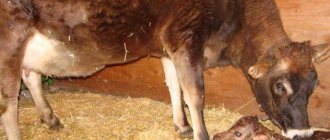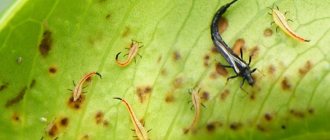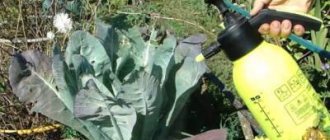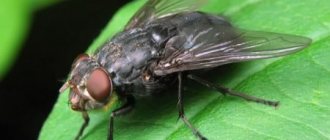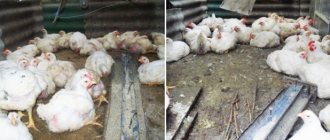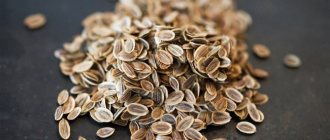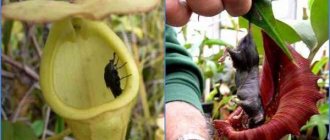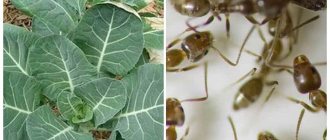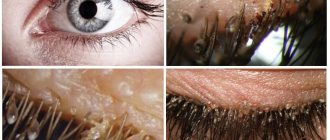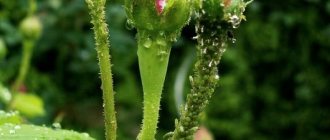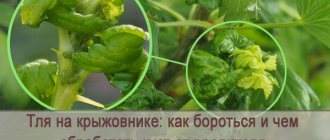Dill has no specific pests, but due to the fact that the above-ground part grows throughout the summer, many are not averse to eating the juicy greens, including aphids. Infection with these parasites is dangerous because effective chemicals cannot be used against them, because dill is regularly supplied to the table and there is a high probability of poisoning. However, many methods have been developed to get rid of aphids, after which the greens can be consumed within a few days after treatment. The question is whether they are effective and whether you can really eat dill after using them.
How to recognize a pest?
There are several species of aphids that parasitize dill, and each species is capable of causing serious damage to the crop, including death.
Signs of aphids are easy to notice with the naked eye.:
- On the tops of the dill (young growths) swarming colonies of insects are visible, and they are also present on the lower part of the stem.
- Dill begins to turn yellow and lag in growth, its top withers and leans to the side.
- A white sticky coating appears on the leaves - sweet honeydew, gradually turning into a black coating.
- Aphids settle not only on leaves, but also on roots.
What aphid attacks dill?
There are several types of aphids.
- Most often, green aphids are found on dill. Small bugs with an oblong body shape, only a few millimeters long. They have six legs and dark antennae. The chitinous coating is weak, translucent, and light green in color. Clusters of aphids on dill are shown in the photo. It is worth noting that green aphids infect the above-ground parts of young plants, piercing the leaves with their proboscis and drinking the juice from them.
- Black or brown aphids on dill are also small bugs with a pointed abdomen and a sharp proboscis. The color is dark gray or black with a grayish tinge. Sometimes dark brown individuals are found. It also feeds on plant sap. But he prefers berry crops - currants, viburnum. Vegetables include tomato leaves and eggplant. Often affects rose bushes. Dill most often comes from infected plants. Overwinters in the soil.
- Gray aphids reproduce on roots and attack thin lateral roots, thereby disrupting vegetative processes. This reduces the amount of nutrients reaching the leaves and the plant slowly dies. It is quite difficult to detect. The greatest damage is caused by larvae and wingless individuals. The larvae rarely reach 1 mm in length and have a spindle-shaped shape. The color is dirty yellow or gray-green. Wingless individuals grow up to 2.5 mm. At this time, the aphid takes on an oval shape. The body is covered with a waxy coating of a grayish tint. With the appearance of wings, aphids fly out of their shelters at the end of summer to lay eggs.
How dangerous is an insect?
The aphid pierces the skin of the leaf with a sharp proboscis and sucks the juice from the plant cells. This weakens them, disrupts internal circulation, and slows down photosynthesis. In addition, it releases poison, due to which the foliage curls and turns yellow, the shoots stop growing, and the stems become bent. Traces of aphids - sweet paths - are an excellent area for the appearance of fungus , and also prevent the plant from breathing fully.
Important! If the gardener does not take any measures, the aphid will produce several dozen generations (up to 50) over the summer and cause significant damage to the area.
Aphid saliva carries a lot of viruses:
- cercospora;
- verticillium wilt;
- powdery mildew;
- fomoz.
Some of the diseases cannot be cured, and the crop is destroyed (more information about diseases and pests of dill is described here).
Symptoms of powdery mildew
Typically, powdery mildew appears on fruit crops in the spring and at the very beginning of the summer, that is, in the first half of the warm season. The first affected leaf blades (shoots) on fruit crops can be detected already in the phase of bud formation. Powdery mildew, as we have already mentioned, most often occurs in fruit crops on leaf blades, but it can often be found on shoots.
In some years, when outbreaks of fungal infection are especially strong, powdery mildew can also be found on the inflorescences; upon closer examination, you can see a very dense, whitish-gray coating, which leads to significant deformation of the inflorescences, their wilting and partial or complete abscission.
At first, a whitish coating also forms on the shoots, and over time, when the volatile spores of powdery mildew ripen, it turns brown-gray, darkening when cleistothecia of the fungus form on it, outwardly looking like black dots.
A white-gray coating also appears on the leaf blades and petioles, but over time it does not turn black, but more often turns red. The development of powdery mildew fungus on leaf blades leads to inhibition of their growth, curling, usually along the central vein, drying out and falling off much earlier than expected.
At the beginning of the formation of fruits, powdery mildew may also appear on them; there you can also see a whitish coating, which, however, disappears quite quickly, leaving behind a rusty mesh that is very reminiscent of fabric, as if caused by hail or other mechanical impacts on the fruit.
It is interesting that at the beginning of its development, powdery mildew can be removed without a trace from any organs of the plant with a simple cloth or other means, but after just a few days, the spots appear again in the same place and are already more serious in size. If no measures are taken, the mycelium becomes denser over time and acquires a brown tint. Fruit crops affected by powdery mildew are severely stopped in growth and development, or these processes are greatly slowed down, the leaf blades wither and fall off ahead of schedule, echoing the flowers and buds.
Reasons for appearance
There are several reasons:
- Insufficient dill care : weakened plants are easier to attack.
- Poor garden cleaning : piles of old organic matter, garbage, and rags are a very convenient place for laying eggs.
- Ants . Sticky honeydew is the main delicacy for them, so they drag aphids from one place to another, and with the onset of frost they hide the eggs deep into the anthill. In the spring, they pull them out and spread them throughout the garden, protecting them from enemies.
In order not to lose crops due to a pest, every gardener should know how to deal with this insect.
Remedy No. 4: garlic infusion
One of the best folk remedies for fighting aphids is garlic treatments. Garlic contains substances that act irritatingly on the integumentary tissues of aphids. In addition, its essential oils work as repellents, making plants “unpalatable” to the pest.
You can prepare a garlic infusion for processing dill as follows:
- Unpeeled garlic heads are taken and passed through a meat grinder;
- 1 glass of the resulting slurry is poured with 3 liters of cold water;
- The container is covered and left in a dark place for 2 days.
Garlic infusion can be left for longer – up to 5 days. The better it infuses, the greater its repellent effect.
Important! Before use, the garlic infusion is passed through a cloth so that small particles do not get into the sprayer and clog the nozzle. Additionally, you can add a small amount of laundry soap to the product.
What preparations should be used to treat the plant?
Let's consider what is better to spray the crop when pests appear.
Fitoverm
The drug is of biological origin, produced in the form of a concentrated emulsion with a specific odor.
Packing:
- in ampoules of 2, 4 and 5 ml;
- bottles from 10 to 400 ml;
- 5 liter flasks.
Once in the stomach of pests, it paralyzes it after 12 hours, which leads to gradual exhaustion and death. Effective only on adults capable of feeding. At least 3 treatments are required to destroy all aphids on the site .
Spraying is carried out at dusk (in the light the product begins to decompose). For indoor plants, the dosages are as follows: 2 ml of the drug per 50 ml of water. Treatment is carried out 4 times per season. For dill, 2 ml of “Fitoverma” is enough, as well as for seedlings.
It is prohibited to combine with pesticides . A 5-liter canister costs about 9,000 rubles (in Moscow and St. Petersburg).
Karbofos
A simple and inexpensive substance, it belongs to the category of popular organophosphorus compounds. It can only be used when there is massive damage to an area, since it has a poisonous effect on both harmful and beneficial insects (including amphibians and fish, in whose bodies it tends to accumulate), and it is not capable of destroying masonry. Another “minus” is that pests are addictive.
Available in the form:
- powder;
- granules;
- aqueous suspension;
- solution.
Dosage : 6 g of dry powder per 8-10 liters of boiled water. To process vegetables, one liter per 10 square meters is enough. The price in St. Petersburg and Moscow varies from 30 rubles and above per package, depending on the volume.
Biotlin
Systemic insecticide of enteric contact action, available in:
- ampoules of 3, 9 and 50 ml;
- bottles of 100 ml.
It has a depressing effect on the nervous system of adults and destroys both larvae and eggs. Do not mix with other drugs.
The mixture is diluted, according to the instructions, in boiled water at room temperature and sprayed on the stems and leaves on all sides, in dry weather 6 hours before watering (if it rains after the procedure, repeat the treatment).
For an area of 10 square meters, 5 ml of the drug and 10 liters of water are needed. The drug is dangerous for beneficial insects; when used correctly, it is not phytotoxic. Cost – from 65 rubles in Moscow and 80 – in St. Petersburg.
Reference! Biotlin Bau is ready for use immediately and does not require dilution.
Drug S-30
A well-proven insecticide. It creates a dense film around the plant, and, accordingly, around insects and egg laying overwintering near it, destroying them within a day. The area should be treated before buds bloom on garden plants and bees fly out.
Acceptable proportions: 500 ml per 10 liters of water or 250 ml per 5 liters of water. To treat greens, you need from 2 to 5 liters of solution. Has a 3rd class of harmfulness.
Price in Moscow: 250 ml - 90 rubles, 500 ml - 170 rubles, in St. Petersburg the cost is the same. Available in the form of a mineral-oil emulsion, in bottles of 250 and 500 ml.
Follow safety precautions when working with insecticides and chemicals:
- Protect your mouth and nose with a special mask, wear thick gloves on your hands, rubber boots on your feet, and special glasses on your eyes.
- Do not eat, drink or smoke during treatment.
- It is forbidden to use kitchen utensils to prepare the solution, but only disposable ones.
- Keep pets, children and pregnant women away from the area.
- If the drugs get on your mucous membranes, immediately rinse them with plenty of water; if the mixture gets into your stomach, induce vomiting and go to the hospital.
Effective folk methods of fighting aphids
In order to rid dill plantings of aphids, folk remedies are often used. Their popularity is understandable. They are absolutely safe for humans, which allows the greens to be used for food almost immediately after processing. In addition, most of them do not need to be specially purchased in a store, but can be easily found in the house or in the garden.
Wood ash
Ash obtained from burning wood waste is widely used by gardeners. Thanks to the potassium, calcium, phosphorus and some microelements it contains, it is an excellent fertilizer. Ash also helps in the fight against insect pests, including aphids.
An infusion of ash for spraying dill can be prepared in two ways:
- Cold. 2 cups of ash are poured into 5 liters of water and left for at least 12 hours, stirring occasionally.
- Hot. Ash and water are taken in the same proportions as in the first case, but instead of infusing for a long time, they are boiled for 30-40 minutes and cooled.
The finished infusion of ash is filtered and a little liquid or grated laundry soap is added to it. This is necessary to improve adhesion.
Dill is treated with ash infusion daily until the aphids disappear.
Ammonia solution
The effectiveness of ammonia, or an aqueous solution of ammonia (10%), is based on a sharp unpleasant odor that repels insects. Using this product will not only save you from aphids, but will also significantly increase the yield of dill due to the high nitrogen content that the plant needs to grow green mass.
In order to treat dill against aphids with ammonia, it is dissolved in water in a proportion of 1 tablespoon per liter. The resulting solution is sprayed onto the plantings twice a week. The consumption rate of the drug is about 1 liter per 10 square meters. m.
Vinegar
Aphids do not like the smell of vinegar. But acid can burn tender dill leaves, so when using it it is very important to follow the dosage. To prepare 1 liter of working solution, one teaspoon of 7% table vinegar is enough. If the acid concentration is above 7%, then it is first brought to this indicator, and only then used to prepare the working solution.
Spraying dill with vinegar is carried out at least once every 2 days.
Soap
You can also spray dill against aphids with a solution of regular soap. Moreover, both lump and liquid detergents are equally effective.
A soap solution for processing dill is prepared as follows:
- 150 g of pre-grated bar soap or 50-70 g of liquid detergent are dissolved in 5 liters of warm water;
- Before spraying, the resulting solution must be cooled.
Experienced gardeners, when choosing soap for treating dill against aphids, give preference to tar soap. Its smell repels aphids, while the aroma of cosmetic fragrances attracts them.
Important: In stores for summer residents and gardeners you can buy green soap specially created to combat insect pests.
Soda
Another folk remedy that helps get rid of aphids is regular baking soda. It is dissolved in water in the proportion of one tablespoon per liter of water and used for spraying plants.
Effective recipes for baking soda and natural soda against aphids
Milk and iodine
Many gardeners are confident in the miraculous effect of a mixture of milk and iodine. It is used to prevent the occurrence of fungal diseases and as a growth stimulator. It also helps to remove aphids from dill.
The process of preparing an aphid remedy based on milk and iodine includes several stages:
- Add 25-30 drops of alcohol tincture of iodine to 100 ml of warm milk with a fat content of no more than 2.5%.
- Mix the solution thoroughly until it acquires a uniform yellowish color.
- Dilute the resulting liquid with water to a volume of 1 liter and mix well again.
Sprinkle dill with a solution of milk and iodine immediately after preparation. It cannot be stored.
Infusions and decoctions of plants
You can also get rid of aphids from dill growing in your garden using medicinal plants. Their use is safe for humans and pets, and also does not harm the treated plants.
The use of decoctions and infusions of plants to destroy and repel aphids.
| used raw materials | Cooking method | Spraying frequency |
| Onion peel | A ten-liter bucket is half filled with onion peels, topped up with boiling water, covered with a lid and left for 24 hours. Then the infusion is filtered, squeezing out the husks well, and diluted with water in a ratio of 1:2 | Once every 2-3 days |
| Dried tobacco leaves or tobacco dust | 150-200 g of raw materials are poured with 5 liters of hot water and left for 2 days. Strain before spraying. | Once every 2-3 days |
| Dried chamomile flowers | 100 g of inflorescences are poured with 1 liter of hot water and left for 12 hours. The resulting infusion is diluted with water in a ratio of 1:3 | Every day until the aphids disappear completely |
| Garlic | A glass of chopped garlic heads or arrows is poured with 10 liters of water. After a day, the infusion is filtered and diluted with water so that the liquid retains a distinct smell of garlic. | Once every three days |
| Tomato or potato tops | 2-3 kg of green tomato or potato tops are crushed, poured with hot water and left for 6-7 hours. To save time, infusion can be replaced by boiling for half an hour. The resulting infusion or decoction is cooled, filtered and diluted with water in a ratio of 1:4 | Once a week |
| Hot capsicum | • 100 g of fresh hot pepper pods are infused for 10 days in 1 liter. The finished infusion is diluted with water in a ratio of 1:10; | 1 time every 3-4 days |
| • 100 dry pods are poured into 1 liter of water and boiled for 2 hours. Before use, the volume of the decoction is adjusted to 10 liters with clean water. | ||
| Marigold | Fill half a ten-liter bucket with crushed flowers, leaves and stems of marigolds and fill them with 5 liters of warm water (50-60 °C). The infusion is ready for use after 2 days. | 1 time every 3-4 days |
| Celandine | 2-3 flowering celandine bushes are cut at the root, crushed, poured with 10 liters of water and left for a day. | 1 time per week |
| Horse sorrel | 300 g of crushed horse sorrel roots are poured with 10 liters of hot water and left for 2-3 hours. | Daily |
What to do to prevent the occurrence?
It is unlikely that you will be able to completely protect your garden from pests, but reducing the risks is within your capabilities. A few simple rules will help with this:
- Choose the beds correctly: greenery loves areas with good ventilation and lighting, and aphids cannot tolerate drafts.
- You cannot plant the same vegetables for several years in a row in one place - this will deplete the land. Dill should not be planted after umbrella plants (celery, parsley, carrots, caraway), since they have the same set of pests.
- The planting scheme is not a whim, but a necessity. Do not be tempted to plant dill as thickly as possible: young shoots do not interfere with each other, but adults become crowded and lack water and sun. Therefore, leave 25-30 centimeters between the dill beds.
- Bring to your side allies against aphids - ladybugs. To do this, plant plants that attract them: basil, garlic, onions, marigolds.
- Make it a rule to regularly weed the soil: this procedure will not only help the roots breathe and develop properly, but will also destroy some of the aphids (since they like to settle in such secluded places).
- As a preventive measure, spray the area with folk remedies against aphids.
And, of course, regularly inspect your garden for pests and promptly clean it of weeds and plant debris.
Attention! If your garden is in a risk zone and aphids appear on it every year, try covering the dill beds with spunbond.
This is a lightweight, but strong and durable covering material, created by melting polymer fibers, withstands both extremely high and low temperatures, allows light and air to pass through well, does not emit toxic substances, and is affordable.
Dill occupies a special, honorable place in medicine, cooking and cosmetics; at the same time, it is unpretentious in care and can be grown both in the garden and at home. But aphids are a serious enemy, and if you want to harvest a record harvest, pleasing with lush greenery and a pleasant aroma, memorize the rules of pest control. And don’t forget about preventive measures - then your garden will give you only pleasant impressions.
Prevention measures
You can simplify the task of growing dill and prevent the appearance of aphids on plants by following the following rules:
- When planting crops, choose well-lit areas blown by a warm wind.
- Do not thicken the plantings by pulling out excess specimens in a timely manner. An excessive number of plants per 1 m² (more than 1.2–1.5 g of seeds when sowing) threatens with elongated and scanty shoots, without succulent lateral branches. At the same time, aphids like dill in this form even more, so you should not attract its attention with dense plantings.
- In autumn, remove plant debris from other garden crops, which can serve as a refuge for the pest in winter. With the arrival of the first spring warmth, insects will climb to the soil surface, waiting for newly planted young crops.
- When choosing a place to sow dill, make sure that it is at a sufficient distance from other “culinary” green plants: parsnips, celery, parsley and carrots, which can “share” their pests and diseases.
- Inspect the bushes several times a week, checking their usual appearance. At the slightest sign of aphid activity, you need to quickly take appropriate action, otherwise in a few weeks it will be much more difficult to get rid of the insect.
- Plant dill next to onions, garlic, mint, coriander or basil, which will repel aphids. Some flowers have similar properties: begonia, mallow, lavatera.
Chemical insecticides - possible, but be careful
There are many effective insecticides against aphids: Aktara, Karbofos, Hostakvik, Tanrek, Konfidor, etc. Each chemical product has a waiting period - from a week to a month. You won't be able to eat parsley for that long.
Two processing options depending on the season:
- In summer. Cut off all the parsley. Wash it thoroughly from aphids with tap water. Use for canning, freezing or other culinary needs. Treat the bed with the preparation. Wait for the period specified in the instructions and start collecting greens again.
- In autumn. If you have perennial parsley, you have been protecting it all summer with folk remedies, then in the fall you can harvest the last harvest and treat the bed with chemicals.

